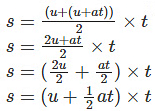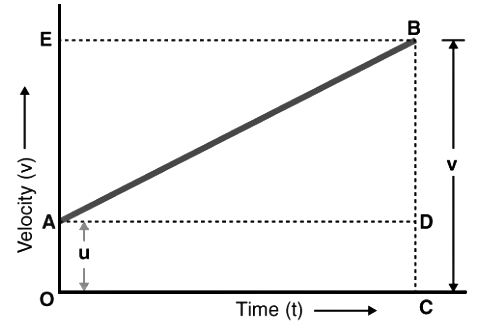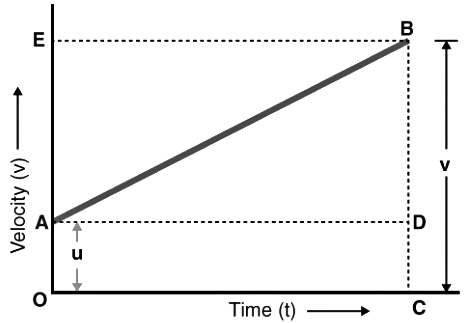Equations of motion of kinematics describe the basic concept of the motion of an object such as the position, velocity or acceleration of an object at various times. These three equations of motion govern the motion of an object in 1D, 2D and 3D. The derivation of the equations of motion is one of the most important topics in Physics. In this article, we will show you how to derive the first, second and third equation of motion by graphical method, algebraic method and calculus method.
Important Derivations: Motion in Straight Line | Physics Class 11 PDF Download
| Table of contents |

|
| Introduction |

|
| Definition of Equations of Motion |

|
| Derivation of Equation of Motion |

|
| Derivation of First Equation of Motion |

|
Introduction
Definition of Equations of Motion
Equations of motion, in physics, are defined as equations that describe the behaviour of a physical system in terms of its motion as a function of time.
There are three equations of motion that can be used to derive components such as displacement(s), velocity (initial and final), time(t) and acceleration(a). The following are the three equations of motion:
- First Equation of Motion :

- Second Equation of Motion :

- Third Equation of Motion :

Derivation of Equation of Motion
The equations of motion can be derived using the following methods:
- Derivation of equations of motion by Simple Algebraic Method
- Derivation of equations of Motion by Graphical Method
- Derivation of equations of Motion by Calculus Method
In the next few sections, the equations of motion are derived by all the three methods in a simple and easy to understand way.
Derivation of First Equation of Motion
Derivation of First Equation of Motion by Algebraic Method
We know that the acceleration of the body is defined as the rate of change of velocity.
Mathematically, acceleration is represented as follows:
where v is the final velocity and u is the initial velocity.
Rearranging the above equation, we arrive at the first equation of motion as follows:
v = u + at
Derivation of First Equation of Motion by Graphical Method
The first equation of motion can be derived using a velocity-time graph for a moving object with an initial velocity of u, final velocity v, and acceleration a.

In the above graph,
- The velocity of the body changes from A to B in time t at a uniform rate.
- BC is the final velocity and OC is the total time t.
- A perpendicular is drawn from B to OC, a parallel line is drawn from A to D, and another perpendicular is drawn from B to OE (represented by dotted lines).
The following details are obtained from the graph above:
The initial velocity of the body, u = OA
The final velocity of the body, v = BC
From the graph, we know that
BC = BD + DC
Therefore, v = BD + DC
v = BD + OA (since DC = OA)
Finally,
v = BD + u (since OA = u) (Equation 1)
Now, since the slope of a velocity-time graph is equal to acceleration a.
So,
a = slope of line AB
a = BD/AD
Since AD = AC = t, the above equation becomes:
BD = at (Equation 2)
Now, combining Equation 1 & 2, the following is obtained:
v = u + at
Derivation of First Equation of Motion by Calculus Method
Since acceleration is the rate of change of velocity, it can be mathematically written as:
Rearranging the above equation, we get
Integrating both the sides, we get
Rearranging, we get
v = u + at
Derivation of Second Equation of Motion
For the derivation of the second equation of motion, consider the same variables that were used for derivation of the first equation of motion.
Derivation of Second Equation of Motion by Algebraic Method
Velocity is defined as the rate of change of displacement. This is mathematically represented as:
Rearranging, we get
Displacement = Velocity x Time
If the velocity is not constant then in the above equation we can use average velocity in the place of velocity and rewrite the equation as follows:
Substituting the above equations with the notations used in the derivation of the first equation of motion, we get
From the first equation of motion, we know that v = u + at. Putting this value of v in the above equation, we get
On further simplification, the equation becomes:
Derivation of Second Equation of Motion by Graphical Method

From the graph above, we can say that
Distance travelled (s) = Area of figure OABC = Area of rectangle OADC + Area of triangle ABD
As OA=u and OC=t, the above equation becomes, 
As BD =at (from the graphical derivation of 1st equation of motion), the equation becomes, 
On further simplification, the equation becomes
Derivation of Second Equation of Motion by Calculus Method
Velocity is the rate of change of displacement.
Mathematically, this is expressed as
Rearranging the equation, we get 
Substituting the first equation of motion in the above equation, we get 
Integrating both sides, we get 
On further simplification, the equations becomes: 
Derivation of Third Equation of Motion
For the derivation of the third equation of motion, consider the same variables that were used for the derivation of the first and second equations of motion.
Derivation of Third Equation of Motion by Algebraic Method
We know that displacement is the product of average velocity and time. Mathematically, this can be represented as:
Substituting the standard notations, the above equation becomes
From the first equation of motion, we know that
v = u + at
Rearranging the above formula, we get
Substituting the value of t in the displacement formula, we get
Rearranging, we get
Derivation of Third Equation of Motion by Graphical Method

From the graph, we can say that
The total distance travelled, s is given by the Area of trapezium OABC.
Hence,
s = ½ × (Sum of Parallel Sides) × Height
s = 1/2 x (OA + CB) x OC
Since, OA = u, CB = v, and OC = t
The above equation becomes
s = 1/2 x (u+v) x t
Now, since t = (v – u)/ a
The above equation can be written as:
s = ½ x ((u+v) × (v-u))/a
Rearranging the equation, we get
s = ½ x (v+u) × (v-u)/a
s = (v2-u2)/2a
Third equation of motion is obtained by solving the above equation:
v2 = u2+2aS
Derivation of Third Equation of Motion by Calculus Method
We know that acceleration is the rate of change of velocity and can be represented as:
We also know that velocity is the rate of change of displacement and can be represented as:
Cross multiplying (1) and (2), we get
v2 = u2 + 2as
|
135 videos|438 docs|100 tests
|
FAQs on Important Derivations: Motion in Straight Line - Physics Class 11
| 1. What are the equations of motion? |  |
| 2. How are the equations of motion derived? |  |
| 3. What is the derivation of the first equation of motion? |  |
| 4. What are some important derivations related to motion in a straight line? |  |
| 5. How do the equations of motion help in solving problems related to motion? |  |




















